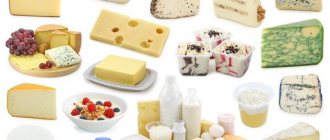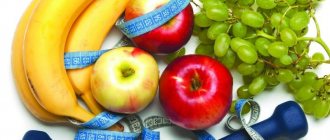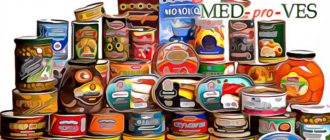Mozzarella cheese is a famous dairy product that has established itself as an ingredient in Italian pizza. Unfortunately, many people only know it as a delicious Italian dish. However, only a certain type of mozzarella is used for pizza - unleavened from cow's milk. But besides this option, there are others. Few people know, but you can find smoked “Mozzarella affumicata” or “Mozzarella di Bufala” made from buffalo milk. The average calorie content of mozzarella cheese is 280 kcal.
The first mention of this product dates back to the 12th century. Moreover, the history of its appearance is associated with the monastery of San Lorenzo. There, the monks often prepared a dish called “Mozza”, as it was considered an exquisite snack for guests.
A couple of years later, the monks decided to reveal the secret of their dish to the townspeople. From that moment on, the sale of cheese began, however, not in our usual form. It was cooked with added salt. And already in the 18th century its large-scale production began. The shape of mozzarella also varies. Depending on it, the name of the product may change. for example, cheese in the form of braids is called “Traccia”, large round ones are called “Bocconcini”, while balls that resemble cherries in size are called “Cileggini”, and very miniature peas are called “Perlini”.
Mozzarella cheese is properly stored in a saline solution and is best consumed fresh. Add it to salads. And for baking and pizza, it is best to choose a special type of cheese “pizza cheese” - it goes on sale in a vacuum bag without whey. Italians themselves love to cook various dishes with this product. After all, the benefits of mozzarella are known to them better than anyone. This delicate cheese harmonizes with various types of berries, as well as with sweet vermouth. In restaurants, cheese is often served in combination with tomatoes, eggplants and basil.
Useful properties and KBJU
The least high-calorie mozzarella is 17% fat; it is recommended to use it when losing weight.
KBJU mozzarella 17% fat per 100 grams:
- proteins – 18 g;
- fats – 17 g (saturated – 11 g, polyunsaturated fatty acids – 0.5 g, monounsaturated fatty acids – 4.8 g);
- carbohydrates – 1 g.
- calorie content – 229 kcal
Mozzarella cheese perfectly saturates the body with beneficial microelements and helps improve the digestion process.
Includes:
- vitamins A (responsible for skin condition: localizes acne, acne); D (strengthens bone tissue); B (increases immunity, overall tone of the body, strengthens the nervous system, helps prevent the development of anemia, improves blood flow).
- calcium, phosphorus, zinc, iron, magnesium, selenium. Mature people are recommended to include this type of cheese in their diet to prevent osteoporosis and maintain bone hardness. Young children are recommended to consume mozzarella to strengthen tooth enamel and also prevent tooth decay.
Calorie calculation for a 200 gram serving
As an example, we will give the calculation of a portion equal to 200 grams - this is one of the standard weight measures that is popular. Its calorie content can be calculated by simple calculation.
The easiest and most universal option (suitable for calculating any volume of a product or ready-made dish) is calculation by multiplying the known calorie content (100 grams) by a factor of 2 obtained from division (200 / 100 grams).
Calorie content of a 200 gram serving = 229 * 2 = 458 kcal.
Mozzarella calories
Mozzarella comes in not only 17% fat content, but 40% and 45%. It depends on the milk from which it is cooked.
Data on the calorie content of Mozzarella cheese are given in the following table:
| % fat content | Squirrels | Fats | Carbohydrates | Calorie content per 100 g |
| 17% | 18 g | 17 g | 1 g | 229 kcal |
| 40% | 21 g | 20 g | 0.3 g | 278 kcal |
| 45% | 21 g | 24 g | 2.5 g | 318 kcal |
Harm
The high calorie content and fat content do not allow Mozzarella cheese to be included in the diet of those people who are on a diet and adhere to the consumption of low-fat foods. Although it has many beneficial qualities, it can be harmful to those who suffer from lactose intolerance.
People with phenylkitonuria are strictly prohibited from consuming phenylalanine, and this amino acid is found in excess in this dairy product. Those who suffer from diseases of the cardiovascular system or impaired kidney function should also avoid Mozzarella cheese to avoid increased blood pressure or swelling.
Three-day cheese diet
By eating mozzarella for three days in combination with other products, you can get rid of one to three kilograms.
To do this, you must adhere to the following power plan:
| Days | 7:00 | 11:00 | 13:00 | 15:00 | 17:00 |
| 1. | 50 ml espresso, 30 g mozzarella | 250 ml green tea, hard-boiled egg | 70 g mozzarella, 250 g turkey fillet | 200 g whole grain cottage cheese | 300 ml 1% kefir |
| 2. | 250 ml green tea (not strong), salad of 30 g mozzarella and one bell pepper | 250 ml green tea, hard-boiled egg | Half boiled chicken breast, 30 g mozzarella, 200 ml mineral water | 2 cucumbers, 100 g mozzarella | 30 g mozzarella, 250 ml low-fat yogurt |
| 3. | 170 g whole grain cottage cheese, 2 large tomatoes | 100 g boiled asparagus, 50 g cheese, 200 ml still mineral water | 200 ml still mineral water | 200 ml still mineral water | One green apple, 50 g cheese |
Note that homemade mozzarella typically contains twice as many calories as store-bought mozzarella.
What are the benefits of cheese?
The beneficial qualities of the product are due to its rich composition: milk fat, animal protein, calcium and potassium, vitamins and minerals. Cheese is perfectly absorbed by the body, and even its protein is much more harmless to the body than the same one made from whole milk.
This product quickly fills you up, and after eating 100 g of cheese, the feeling of hunger disappears. But we must not forget that it is a high-calorie product: 100 g contains 250 - 400 kcal. This variability is due to the fact that cheese is produced in different varieties, enriched with spices and enzymes, so when losing weight you need to be able to choose it wisely.
Diet with mozzarella for 10 days
For more intensive weight loss, you can use a ten-day diet based on soft cheese.
The diet is based on the consumption of certain foods for five days, then it is repeated, but ingredients cannot be added or swapped.
| Days | 8:00 | 12:00 | 16:00 | 18:00 |
| 1. | One cucumber, 200 ml milk, 30 g mozzarella | 20 g mozzarella, 4 tomatoes, several sprigs of cilantro | 30 g mozzarella, cucumber | Quarter chicken breast (boiled, steamed) |
| 2. | 20 g mozzarella, 3 jacket potatoes (without salt) | 100 g Chinese cabbage, 7 radishes | 200 ml milk, 30 g mozzarella | 20 g mozzarella, 3 boiled carrots |
| 3. | 150 g stewed chickpeas, 200 ml black tea without sugar | 250 g grilled asparagus, 30 g mozzarella | 30 g mozzarella, cucumber | 100 g lentils, 20 g mozzarella |
| 4. | 200 ml milk, mozzarella salad (15 g) and bell pepper | 100 g boiled cauliflower | A few lettuce leaves, 20 g mozzarella | 150 g boiled veal |
| 5. | 2 tomatoes, 20 g mozzarella, 300 ml 1% kefir | 250 g stewed or baked zucchini, 30 g mozzarella | 2 cucumbers, 15 g mozzarella | 70 g celery, 150 g boiled turkey fillet |
In the process of losing weight, do not forget about physical activity, which is an integral part of any diet. Walking in the fresh air or swimming will help speed up the process of getting rid of extra pounds.
Choosing and storing cheese
The name of the product variety depends on the size of the balls:
- bocconcini - one large ball with a diameter of approximately 5 cm;
- chiliegini - several medium balls with a diameter of 1.5-2 cm;
- perlini - small balls with a diameter of 0.5-1 cm.
The brine in which the cheese is stored is cloudy white. Thanks to this solution, the product does not dry out for a long time. The shelf life of natural mozzarella does not exceed 30 days, and for the products of some manufacturers it is even shorter.
Once the package is opened, the cheese must be consumed as soon as possible, as it cannot be stored in air.
calorie content versus benefits
You can also use it when losing weight. But this must be done in moderation. This cheese has been known since the 12th century; it was prepared in a monastery in the city. Moreover, when preparing mozzarella, black buffalo milk was used and only fresh.
Now this cheese is made from the milk of ordinary cows. Since the cheese contains milk, which is not heat-treated, the product retains all the beneficial components. In addition, this cheese contains protein, fatty acids, and essential amino acids. Is it possible to eat this cheese while losing weight? It is possible, however, you need to do it correctly. Mozzarella should be consumed in small quantities.
It is best to combine cheese with vegetables or herbs. You can also combine it with berries and fruits. But you shouldn’t combine mozzarella with meat, otherwise it will be difficult for the body to digest food. What are the benefits of mozzarella? First of all, it contains many valuable substances. In addition, the calorie content of cheese ranges from to kcal per g.
Mozzarella is a popular Italian cheese that has a pleasant aroma and delicate taste. It can be used to prepare many dishes. You can also use it when losing weight.
This is a lot, but less than what is contained in many other cheeses. The protein contained in cheese is very useful. It is quickly absorbed and promotes long-lasting satiety. Losing weight with this cheese will help diversify your menu. After all, this product is added to various dishes. Not everyone can eat this product. You should not use mozzarella if you have glomerulonephritis, kidney failure, stomach ulcers, or high blood pressure.
This cheese should not be eaten if it is not fresh, as this can lead to serious health problems. There are no diets that allow you to consume this cheese in large quantities. However, mozzarella can be used in various diets that involve the consumption of dairy products. For example, a weekly fermented milk diet allows you to eat cottage cheese, feta cheese, mozzarella, Adyghe cheese, grain bread, chicken, vegetables, fruits, fish, veal. During the day you should eat at least two types of cheese and cottage cheese.
But all this is in small quantities. You can drink liquid yogurt, fermented baked milk, green tea, kefir, coffee. The five-day diet also includes mozzarella, cottage cheese, vegetables, seafood, berries and fruits. However, it is believed that real mozzarella should be freshly prepared, no older than one or two days. In any case, beware of mozzarella if the shelf life on the packaging exceeds one month.
What should this young cheese look like and what should be indicated on the packaging? High-quality and healthy mozzarella can only contain milk, sourdough and the solution in which this cheese is stored: water and salt. The expiration date, we repeat, should not be more than a month. Most often, vacuum packaging contains a soft, pliable whole piece weighing up to a gram.
But you can also find mozzarella in the form of balls of different sizes, cut into circles or in the form of a braid.
What kind of cheese can you eat while losing weight: the benefits of the product
The color should be light, almost white. Mozzarella, unlike other cheeses, is made without the use of dyes, but the slight yellowish tint can be explained by the presence of carotene in the fresh grass that cows eat. And, of course, when opening the package, pay attention to the smell. An unpleasant sour smell indicates that it is unsuitable for food. And, of course, fresh mozzarella cheese should not have a bitter aftertaste.
And now a few words about the most pleasant thing: how to eat this most useful product in order to give yourself complete taste and aesthetic pleasure. When you have a product like mozzarella in front of you, the calorie content may not bother you.
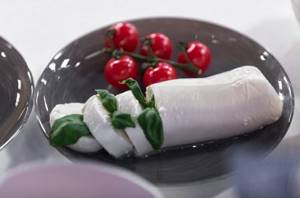
Feel free to use it for sprinkling pizza and any casseroles instead of hard cheese and mayonnaise. It goes well with tomato slices in a simple and elegant salad.
To experience the true taste of an Italian dish, add fresh or dried herbs such as basil and olive oil. If you are trying to follow a diet, but cannot deny yourself evening snacks, mozzarella, calories
calorie content versus benefits
A modern version of “The Book of Tasty and Healthy Food” could devote more than one chapter to cheese. And speaking of dietary nutrition, it is first of all appropriate to remember semi-soft and low-fat varieties, including mozzarella. We will talk about the technology for making this delicate cheese, its benefits as a food product and the subtleties of choice.
Nutritional and dietary value
Is cheese such as mozzarella suitable for dietary nutrition? The fat content of this variety averages about 40%, which is less than many hard cheeses. At the same time, one of the advantages is the high protein value and the highest calcium and phosphorus content among cheeses. And although mozzarella, whose calorie content, depending on the manufacturer, can range from 250 to 300 kcal, contains virtually no carbohydrates, it can be an excellent... dessert. This means it will delight you with the most delicate taste, without making you regret what you ate. There is also evidence that regular consumption of this cheese has a beneficial effect on sleep. And a piece eaten after a meal is also a useful alternative to the well-known chewing gum to protect teeth.
Can everyone use it? Yes, if cheese is not contraindicated for you in principle (this means rare cases of intolerance to milk and products made from it). If you follow the technology and storage rules, it is absolutely safe and does not contain substances potentially harmful to us.
How is mozzarella cheese made, whose calorie content, as we have already said, is quite low, and the digestibility of nutrients is higher than that of many other healthy products? It is made from very fresh milk and rennet using the same technology, which excludes the addition of any other substances. The cheese is immersed in a saline solution and packaged. Vacuum packaging allows you to slightly extend its shelf life and makes transportation possible. However, it is believed that real mozzarella should be freshly prepared, no older than one or two days. In any case, beware of mozzarella if the shelf life on the packaging exceeds one month.
Appearance and information on the label
What should this young cheese look like and what should be indicated on the packaging? If it is really mozzarella, its calorie content will be 250-300 kcal per hundred grams, fat content from 20 to 40, but usually within 35%. High-quality and healthy mozzarella can only contain milk, sourdough and the solution in which this cheese is stored: water and salt. The expiration date, we repeat, should not be more than a month. Most often, vacuum packaging contains a soft, pliable whole piece weighing up to 200 grams. But you can also find mozzarella in the form of balls of different sizes, cut into circles or in the form of a braid. The color should be light, almost white. Mozzarella, unlike other cheeses, is made without the use of dyes, but the slight yellowish tint can be explained by the presence of carotene in the fresh grass that cows eat. Vacuum-packed cheese should have a uniform consistency, without crust or cheese “holes.” And, of course, when opening the package, pay attention to the smell. An unpleasant sour smell indicates that it is unsuitable for food. And, of course, fresh mozzarella cheese should not have a bitter aftertaste.
What do they eat with?
And now a few words about the most pleasant thing: how to eat this most useful product in order to give yourself complete taste and aesthetic pleasure. When you have a product like mozzarella in front of you, the calorie content may not bother you. Feel free to use it for sprinkling pizza and any casseroles instead of hard cheese and mayonnaise. It goes well with tomato slices in a simple and elegant salad. For a true Italian flavor, add fresh or dried herbs (like basil) and olive oil. If you're trying to stick to a diet but can't resist an evening snack, mozzarella, which has very few calories per slice, is a great way to soothe your stomach and taste buds. A few pieces of cheese, mineral water and a glass of red wine - and late guests will no longer threaten your figure. Only benefits and delicate taste.
What kind of cheese can you eat while losing weight?
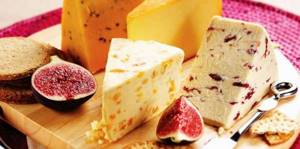
When thinking about your diet, it is best to choose cheese for weight loss with a low percentage of fat, carbohydrates and low calorie content. This includes Ricotta, it contains only 174 kcal, this curd cheese is irreplaceable on a diet. It is worth paying attention to Amber, Oltermanni, Mozzarella, Camembert with mold, feta cheese, Adygei, Tofu. Feta is healthy and tasty; it has more calories (290 kcal per 100 g), but it contains almost no carbohydrates, which cause rapid weight gain. You can eat these varieties in the morning, afternoon and evening without fear of gaining weight.
Brynza for weight loss
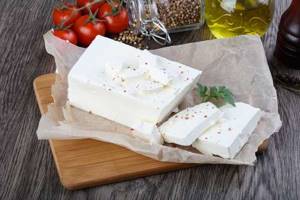
Bryndza is accepted with great success as one of the important components of the diet. And this is not surprising, because it contains a lot of protein, which is usually what effective diets are based on. Moreover, even a specific diet based on this product has been developed. True, it is difficult to call a period of three days a diet; rather, it is a prolonged fasting day. The menu is extremely simple:
- breakfast consists of: a piece of rye bread with a piece of feta cheese,
- lunch includes: vegetable salad (tomatoes + cucumbers + cabbage) + 100 g of feta cheese,
- for an afternoon snack, limit yourself to a glass of kefir,
- For dinner, prepare 100 g of cheese.
As mentioned above, you should eat this way for no more than three days. At the same time, as one can judge, the diet is not very rich, so it is strongly recommended to accompany it with a multivitamin complex. During this period you can get a fairly significant weight - 2 kg. Remember the importance of fluids while dieting to avoid becoming dehydrated.
How to make mozzarella cheese at home
2 liters of fat milk, 2 tbsp. l. lemon juice, salt, rennet on the tip of a knife, 1.5–2 liters of water.
Dilute rennet in half a glass of water. Heat the milk to 70 °C, add the diluted enzyme and lemon juice, stir, do not bring to a boil. Drain off the whey and squeeze out the cheese mixture with your hands. Heat the water to 90°C and remove from the heat, add salt, put the cheese in the water for a few minutes until it becomes very viscous and soft. Mash and stretch the cheese by dipping it into hot water several times for 2 minutes. The mass should be almost homogeneous. Then put it on the board, stretch it with your fingers and fold it into an envelope. Then put it back into hot water to soften. Place cling film on the table.
Remove the cheese from the water, roll it into a sausage, wrap it tightly in film, and tie the sausage tightly in several places with a thin rope to form separate balls. Transfer the resulting balls into a container with whey and store in the refrigerator.
Calorie content of cheese - table of calorie content of many cheeses. Interesting!
Classic recipe
Mozzarella is a cheese whose classic recipe allows you to prepare the product at home , because it does not require a large number of rare ingredients.

Ingredients of the classic recipe
To create cheese according to the classic recipe, you need to use the following ingredients:
- milk – 4500 ml;
- water – 300 ml;
- citric acid – 10 g;
- rennet – ¼ part of the tablet and ¼ tsp;
- salt – 8 g.
Step-by-step cooking process
- The first step is to prepare citric acid and rennet. For this purpose, the acid should be dissolved in 200 ml of cold water. Combine the enzyme with the remaining water (100 ml).
- Then you need to pour the milk into the pan and add citric acid, without stopping stirring with a spoon. The liquid should be heated to 33 degrees. If the milk has not started to curdle, then it is time to heat it to a temperature of 35-37 degrees.
- Next you need to add the enzyme. To do this, remove the pan from the stove and slowly pour in the enzyme, stirring the milk. Then, after half a minute, stop stirring the milk and cover the dish with a lid. Leave the composition in this state for 5 minutes.
- If, after this time, the contents in the bowl acquire the consistency of custard with clear boundaries of curd particles and whey, it is time to proceed to the next process. Otherwise, cover the container with a lid again and leave to infuse for another 5 minutes.
- The resulting curd must be cut into cubes with a knife, without reaching the bottom with the device.
- After this, put the pan back on the fire and gently stir with a spoon, without disturbing the shape of the cubes. The contents of the dish should be heated to a temperature of 41 degrees.
- Then you need to remove the mass from the heat and stir for another 5-7 minutes. With longer heating times, the cheese becomes harder.
- At the next stage, you need to separate the curd from the whey using a slotted spoon, which is recommended to be covered with several layers of gauze.
- It’s time to transfer the resulting clot into a microwave-safe bowl and heat for 30 seconds.
- It is recommended to measure the temperature of the mass using a thermometer; it should reach 60 °C.
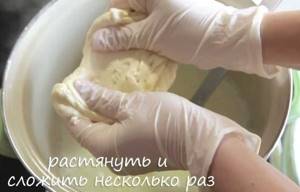
Next, you need to stretch the mass, which has gradually begun to lose its cube shape, and form one large ball or many small balls. This should be done by squeezing and rolling the mass in your hands until a glossy shine is obtained.- Then you need to add salt to the cold whey, place the balls in it and put it in the refrigerator for storage.
What can I add?
The recipe involves using cow's milk. If you don’t have one in your kitchen, you can replace it with something else.
How to serve a dish
Mozzarella is a cheese that can be easily prepared at home and served as a snack . The product can also be used to create salads. Cheese will make an excellent companion to products such as tomatoes and basil. People especially often use these products for making pizza and Italian pasta.

